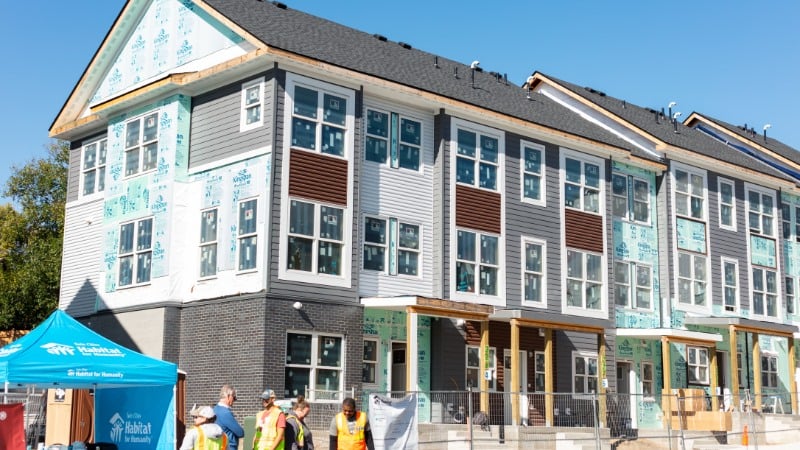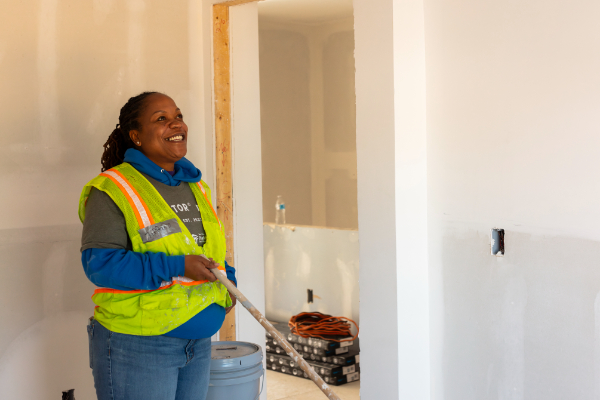"Yaa Mana Ofii" -- Home is Everything for Habitat Homebuyers
“Yaa mana ofii.” This Oromo language phrase is very common in Ethiopia. It means, “home is everything.” Yemane and Bizunesh, who bought their new...
3 min read
 Regina Eckes
:
1:01 PM on January 5, 2024
Regina Eckes
:
1:01 PM on January 5, 2024

In order to build 17 Harrison Townhomes by summer of 2024, Twin Cities Habitat needed a new approach to how we utilize subcontractors and volunteers. The new model is proving to be a success in keeping costs down, streamlining work, and creating a better experience for volunteers.
In August, 2022, Twin Cities Habitat broke ground on a small, unused plot of land in the Harrison Neighborhood of Minneapolis with a plan to build 17 affordable townhomes on the site. Speeches were made and everyone was excited to get started. But how were we going to build 17 townhomes and have them ready for families within 18 months? That's where the strategy of increasing our use of subcontractors came into play.
For a typical single-family home, Twin Cities Habitat subcontracts out HVAC, electrical, and plumbing work; volunteers are responsible for all other interior and exterior work, including siding, roof work, and even framing. But for Harrison Townhomes, we also subbed out the framing, siding, and even the mudding and taping. "This allows volunteers to focus on painting and trim, installing cabinets and hardware, and flooring," said long-time Site Supervisor McKinsie Clyde.
One of the main benefits of subbing out labor-intensive work is speed. Because subcontractors do things like roofing and siding every day, they’re naturally able to complete work quicker. They also allow everyone on site to be working at the same time. "Subs were still framing the last 14 units while we were starting our finishes on the first and third units," McKinsie said.
If we built and completed each unit one at a time, using only volunteer labor, Harrison Townhomes would have taken 3-5 years to finish. Instead, our townhomes are expected to be completed in 18 months.

There is a significant cost-savings to using subcontractors, too. On a single-family home, Habitat rents multi-level scaffolding and heavy equipment, such as a forklift, for volunteers to do exterior work. On the flip side, subs provide their own equipment. McKinsie explained that if Harrison utilized only volunteer work, "we'd have to do scaffolding around the entire building for the duration of framing, roofing, siding, and painting. Now, we don't have a forklift, we don't have a big machinery cost, and we don't have the scaffold cost."
With subcontractors doing the heavy lifting, site supervisors have more time and brain space to focus on providing a better experience for volunteers. Volunteers also don’t need to take the same safety risks, as not everyone is comfortable working on a roof or walking on multi-story scaffolding. At Harrison, volunteers spend time on finishing work and developing skills they’re more likely to use in their everyday lives and even in their own homes.

"Our volunteers come in at the point of mudding and taping being done, which means our sheetrock is up,” McKinsie explained. “We dust everything, we clean everything, scrape the floor and all of that. We paint, do flooring, cabinets, doors, trim, everything inside from that sheetrock point on. So, there's still a ton of work."
At Harrison, volunteers also don’t have to worry about bad weather conditions, which is incredibly helpful during winter, as well as the hot and humid days of summer. Currently, each Harrison unit is well insulated and has one space heater on the lower level. With heat rising, volunteers and staff are very comfortable working in 60- to 65-degree temps. "We can work in a snowstorm or a rainstorm right now and it's not affecting us in the slightest," McKinsie said.
But don’t be fooled by Habitat’s use of subcontractors – volunteers are more important than ever. At Harrison, "we had volunteer labor for less than a year and it saved two to two-and-a-half million dollars just on that plot of land. We’re now faster with volunteers – they’re doing an amazing job," McKinsie explained.

Using a mix of subcontractors and volunteers on multi-unit builds like Harrison Townhomes is necessary to keep pace with the number of homes Habitat strives to build and the number of families we aim to serve.
"If you think about how many volunteers we need per project in order to get all of our projects done, we have to look at how we can resource our labor," McKinsie said. Expect Habitat to use this new model on our largest project ever – 150 new units at The Heights in St. Paul.
"This model has been very well researched, numbers have been discussed endlessly before starting this. And I think we're kind of rolling with how this model is working so that we're not going to find out the hard way that this isn't a fit," McKinsie said. "The way Harrison has gone has been really successful."
Your gift unlocks bright futures! Donate now to create, preserve, and promote affordable homeownership in the Twin Cities.

“Yaa mana ofii.” This Oromo language phrase is very common in Ethiopia. It means, “home is everything.” Yemane and Bizunesh, who bought their new...

As we rapidly approach the 2024 Jimmy & Rosalynn Carter Work Project taking place right here in the Twin Cities, we're taking a moment to focus on...

When Russ retired from U.S. Bank after serving in the IT Department for 20 years, he knew he wanted to do two things: